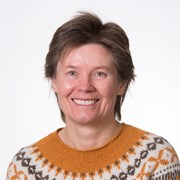The debate rages on with no compromise in sight. There is traffic chaos on the E18 motorway in Asker og Bærum. There are too many cars and the jams are getting worse.
SINTEF researcher Astrid Bjørgen is working to find long-term solutions to problems like this without resorting to building more and wider roads.
Starting early is key
The simple solution, which has proved to be very difficult to achieve, is better planning of new housing projects. Start early, and make space for facilities such as online shopping deliveries and vehicle charging, car sharing and service provision.
Bjørgen and her colleague Hampus Karlsson have actually been conducting research in Asker, and more specifically, into a large housing development project at Vestre Billingstad.
Fewer cars
“The developers were required to facilitate a reduction in the use of private cars”, says Bjørgen. “They were issued with limits on the volumes of private cars entering the E18 from the new development, as well as additional requirements appended to development plans agreed with Asker municipality. Moreover, the municipality stipulated that if the area was to be developed, effective car mobility solutions must be put in place”, she says.
There are four major developers involved. Each has responsibility for his own part of the project, and Ferd Eiendom is responsible for the final lot.
“Ferd wanted data on people’s travel habits and were looking to identify solutions in the early planning stages”, says Bjørgen.
The keyword here is ‘early’. According to Bjørgen, good solutions are achieved when internal pedestrian and cycle paths are planned at a very early stage, and that dedicated areas are set aside for these, together with parking spaces and car mobility solutions.
Online shopping deliveries and sharing solutions
At the same time it is essential that sharing solutions are integrated into the planning process. That is to say, solutions that enable residents to lease or share cars, or bicycles for that matter. Space must be found for home delivery boxes, making it easier for residents to shop online.
There must also be effective planning for necessary and essential vehicle access, such as for refuse collection, package delivery and tradespersons.
“It is important to consider these areas as multi-purpose spaces, and to see them in relation to service and supply needs”, says Bjørgen. “A plumber, for example, has to park close to the flat where he or she is carrying out repairs. There has to be room to park and to unload tools and materials from the van. There must be access for taxis and community nurses to park close to individual flats, although we don’t need to plan for a permanent taxi rank 24/7”, says Bjørgen.
Here is a summary of Bjørgen’s recommendations:
- Areas dedicated to internal pedestrian and cycle paths that are linked to parking, car mobility systems, package delivery stations and refuse collection points must be included in the early planning phase.
- These areas must be designed for multiple use and planned to facilitate service and supply vehicles entering and exiting residential areas.
- Business models for sharing solutions and services provision must be established such that provision is guaranteed in the long term and further developed in step with any changes in demand and new terms of reference.
- In addition to existing planning provisions, a separate development agreement may be entered into with the municipality in order to guarantee the desired development. Clear requirements also contribute towards reducing risk for the developers.
SINTEF has conducted this project in collaboration with Asker municipality, the developers Ferd Eiendom, the Norwegian postal service Posten and the car hire company Otto, with funding from the Viken County Regional Research Fund.
Parking place as an ‘extra’
Bjørgen does not believe that planning according to her recommendations means that more space will be lost. “We must simply design intelligently, while at the same time focusing on nature-based solutions with green spaces and the stream that runs through the area”, she says.
She speaks of how those buying a flat in Vestre Billingstad will have to make an active choice as to whether or not they purchase a parking space to go with it. It is also required that all residents register under a joint ownership scheme. Under this scheme, the developer will pay for the operation of the car mobility solutions during the first five years.
Everyday logistics
“This requires that the information about these solutions must be presented effectively”, says Bjørgen. “The joint owners, the developers and the mobility suppliers must thus prepare a business model during the initial years”, she says.
The researchers have conducted a survey among residents who have already moved into the first homes on the Vestre Billingstad site. Bjørgen is looking into how what they learn from this survey can be used in other major development projects.
“If people are to enjoy their lives here, we have to put a lot more thought into such things as green spaces, public health and everyday logistics”, says Bjørgen. “Everyday logistics are key to reducing transport needs. Sharing solutions involve sharing things such as car use, the charging infrastructure and cycle repair stations. This also applies to communal areas. You don’t need a guest room all the time, so wouldn’t it be better to share a room that can be loaned out to those who need it?”, she asks.
“People who live in projects like these are very keen to have access to communal meeting places and social activities”, says Bjørgen. “When we talk to residents we see that the future is all about communal meeting places, access to green spaces and daylight”, she says.
Reference:
Astrid Bjørgen and Hampus Karlsson: Arealplanlegging og mobilitet (Area planning and mobility). SINTEF Fact Sheet, 2024.
Project: Samspill mellom reise- og handlevaner, mobilitet, logistikk og områdeutvikling. Case Vestre Billingstad (Interaction between travel and shopping habits, mobility, logistics and area development. The case of Vestre Billingstad).


